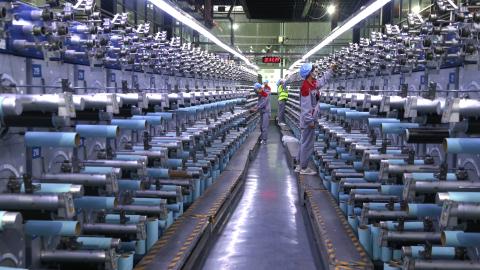The spectacular recent growth in Russian and Chinese nuclear arms is leading Washington’s think tanks to devote a lot of time these days to the reality of trilateral nuclear arms competition.
This is not altogether a new and novel concept: the Soviet Union faced a nuclear competition with the United States (which included NATO, the British and French nuclear deterrents, and forward-deployed U.S. nuclear weapons around the world) and the People’s Republic of China. Recall the Soviets and the Communist Chinese almost had a nuclear conflict in the 1960s.
But this time the shoe is on the other foot, and now it is the U.S. that faces the Russian Federation and the People’s Republic of China, along with the increasingly likely scenario that Putin and Xi may cooperate at least regarding the timing of intervention against American interests.
And while there are important debates to be had full of nuance and grand theory about how the United States could deter both Putin and Xi, including simultaneously, there is a more fundamental concern: will our nuclear forces be capable of deterring even one of these hostile regimes?
Since the end of the Cold War, the United States has lost its seriousness about its nuclear forces, including production and scientific infrastructure, and, at times, has been unsure about whether it even should maintain those forces. Only misplaced American self-confidence could allow our nation to believe this situation could go on indefinitely.
The advances of our adversaries’ nuclear weapons programs have been well-documented in the public debate. During the Trump Administration, in which I served, a serious effort was made to explain to the American people, and their allies, that it was past time to stop thinking about arms control as only a bilateral matter. More recently, the China military power reports of the Biden Administration’s Department of Defense have added to the volumes of public information demonstrating why Americans, and their allies, should be increasingly concerned about the investments China and Russia are making in their nuclear forces.
If you remember nothing else about all these reports, you should take away that our adversaries are capable of building hundreds of new nuclear weapons per year and have, in some cases, multiple programs underway to modernize each component of their nuclear order of battle—beyond merely the commonly thought of triad.
Then there’s America’s nuclear force: every nuclear weapon in the U.S. arsenal, and every system to deliver those weapons to their assigned targets, is beyond its design life.
Our Minutemen III ICBMs were fielded in the 1970s. The replacement system is already late (only three years into the program)—which is not surprising as we have not fielded a new ICBM in 50 years.
Our B52 heavy bomber, which first flew in 1954, will fly into the 2050s and probably beyond; there are some who say that the last mother of the last B52 pilot hasn’t been born yet. America’s B2 fleet of heavy bombers (all 19 of them) were on a safety stand-down for five months. Our new B21 bomber has been in development since 2009 and has not flown yet, according to press reporting.
The Columbia class submarine won’t hit the water for six years and it is struggling to retain margin to remain on schedule. We may now have to spend money to further extend the life of Ohio-class submarines beyond their 30-year design life and their 42-year extended lifetime.
By 2035, the same year DOD reported that the Chinese will reach rough numerical parity with U.S. deployed forces, 100% of U.S. nuclear weapons (the warheads and bombs) will have exceeded their design lives by an average of 30 years. They will not be 30 years old, they will have exceeded their design life by 30 years.
The United States has agonized for years about how to sustain its nuclear weapons. During the Bush Administration, the plan was the Reliable Replacement Warhead (RRW), which would have been a “new” weapon with a “new” design to replace the W-76 submarine-launched warhead. Its “newness” was its peril and it was cancelled before the end of the design phase of development to satisfy those who believed the U.S. shouldn’t build “new” nuclear weapons.
So, instead, the W-76 and other warheads are sustained by a “refurbishment” approach where current parts are swapped out with like-for-like parts—this W-76-1 is planned to be able to exceed the W76’s 20-year design life by 40 years.
Similarly, the United States is refurbishing the B-61 gravity bomb so that it may remain in service in the extended deterrence mission. Refurbishment in this case involved replacing vacuum tubes…in nuclear weapons.
These are just the weapons themselves—the production capacity to sustain them is in worse shape.
The United States invented plutonium in 1941. Yet, it has not been able to build a plutonium pit for the nuclear weapons stockpile since 1989, when the Rocky Flats plant was shut down.
In 2001, the George W. Bush Administration proposed a “responsive infrastructure” as part of its Nuclear Posture Review to restore pit production capacity (John Harvey, “Seeking a Responsive Nuclear Weapons Infrastructure and Stockpile Transformation.” August 11, 2004). This “responsive infrastructure” would include the Modern Pit Facility, to be able to build plutonium pits to sustain U.S. nuclear weapons, with at least 125 of them per year (what was then, in the benign geopolitical environment of the early 2000s, thought to be required).
Ultimately, the Modern Pit Facility died, to be replaced by a new plan to reconstitute a U.S. pit production capability: the Chemistry and Metallurgy Research Replacement-Nuclear Facility (CMRR-NF). It was also central to the Senate’s decision to support the New START Treaty, wherein President Obama certified that he would accelerate the construction of this facility to restore pit production. The project was terminated by that Administration slightly more than three years after New START was ratified.
Now, the plan is to split plutonium production between the Los Alamos National Laboratory and the Savannah River Site with a goal of 80 pits per year by 2030. This level of production which has also been a congressional requirement since 2019, and is far lower than was thought necessary in a far more modest threat environment.
Last year, however, Dr. Jill Hruby (the NNSA Administrator) testified to Congress that “there is no path” to meet this requirement—regardless of how much funding was made available. The significance of this statement has not been fully appreciated by policymakers.
Just consider: General Anthony Cotton, USAF, the current head of U.S. STRATCOM, informed Congress this Spring that “Russia continues to update its warhead production complex and is producing hundreds of warheads each year.” Further, he explained that Russia is exporting its Highly Enriched Uranium to the People’s Republic of China for its CFR-600 fast breeder reactors, which produce plutonium. Yet, since 2001, the United States—again, the country that invented plutonium—has been struggling to restore the ability to produce this basic nuclear trigger for its weapons despite countless billions spent on decades of studies and failed plan.
And consider this: in 1951, the Atomic Energy Commission asked Dow Chemical to manage a nuclear weapons production site outside of Denver. On July 10, 1951, ground was broken. By 1953, plutonium pits were being manufactured and shipped to the Pantex Plant in Amarillo, Texas, for use in America’s growing nuclear weapons stockpile.
U.S. uranium infrastructure is also woefully out of date, with a uranium fire earlier this year nearly shutting down the one facility where we produce these components for our nuclear weapons. In 2014, a 300-pound block of concrete almost fell on a worker at this same facility, which has been in operation since the Manhattan Project. Such an accident also surely would have led to a total stand-down in operations at the facility. The capacity for producing other critical capabilities for U.S. nuclear weapons – like lithium and tritium – is similarly at-risk.
We are at the dawn of a three-way nuclear competition in which the United States is the odd man out. We can’t produce new nuclear weapons currently—nor for the foreseeable future—if required by either strategic or technical circumstances. And the U.S. waited until the last possible minute to replace each-and-every delivery system, and we chose to replace them all at once. To add to the risk we face: Russia is on the verge of destroying the last bilateral nuclear arms control treaty.
So what near-term options exist to provide the president with additional deterrence options and capabilities, for example, in the event Russia’s suspension of the New START Treaty turns into a full-fledged breakout?
While the U.S. has a triad when the force is “fully generated”, day-to-day we have a dyad of ICBMs and ballistic missile submarines. The previous Air Force A-10, Lt. Gen. James Dawkins, Jr., warned that attempting to “re-alert” America’s nuclear bombers as a hedge would exhaust the force in roughly six months.
The U.S. Navy is planning to field an improved Trident D5 missile for the Columbia-class submarine in the coming decades, but for now, would there be sufficient missiles if the decision was made to reload the current Ohio-class boats to respond to a near-term threat or to bridge the transition from Ohio to Columbia?
Or with GBSD delayed, what options exist for the Air Force to “upload” warheads onto the Minuteman III ICBM during a transition to the new ICBM since the United States has only fielded a single warhead on each missile since 2010? Has an upload capability been preserved?
The bottom line is: there is reason to be concerned that the U.S. has almost no near-term or mid-term options to respond to Russia’s and China’s rapidly growing nuclear weapons programs.
Indeed the only real option for near-term deterrence options for the President may be missile defense.
While Russia and China continue to improve their missile defenses to counter U.S. and allied forces, Americans continue to choose to ignore down-play this tool, including in the most recent missile defense review.
We are witnessing the capability of our theater-range missile defense in the Ukraine conflict today. It turns out we actually can deploy missile defenses to counter peer rivals. And, of course, Israel has done this for more than a decade.
Commercial industry launched almost 1,800 satellites last year; one company’s satellite layer consists of well over 3,200 individual space vehicles of about 580 pounds each. Those who would say it is too hard or too expensive to build space-based missile defense are clearly caught in a Cold War mindset.
A serious re-think of what the United States can do with its national security and commercial space capabilities to provide effective missile defense of the homeland (against ballistic and hypersonic glide vehicle weapons) may be the nearest-term option to significantly improve our deterrent posture.
Decline is a choice. The United States does not have to accept that we seem incapable of moving fast these days.
We have just seen a remarkable demonstration of what this country is still capable of when it chooses to be serious: with a large appropriation, military and civilian leaders who had actual authority and political support from the highest level to ignore “peacetime rules” and get things done quickly, the nation went from zero COVID vaccines to four in about six months and quickly surged them into production to beat the virus that escaped from a lab in Wuhan, China. And the world wanted America’s vaccine, not China’s or Russia’s.
This is the approach to recommend for the next president regarding the nuclear deterrent (and a credible missile defense): invest his or her leadership, obtain the resources, and hold the bureaucracy accountable for putting process ahead of capability.
There will be a strong temptation to push for a major reorganization of departments and agencies to demonstrate seriousness of purpose; such a move will eventually be necessary. But at this inflection point, the U.S. needs a modernized deterrent to respond to new threats, not new org charts, stationery, and business cards.
Past stewards of the nation’s nuclear deterrent used to say what worried them the most was having to call the president in the middle of the night to inform him there was a problem with a particular nuclear weapon in the stockpile or deployed force. They knew the president would have asked, “What’s the plan to fix this?”
The next president-elect should ask for that plan on November 6, 2024. It should be National Security Council Directive 1.


















